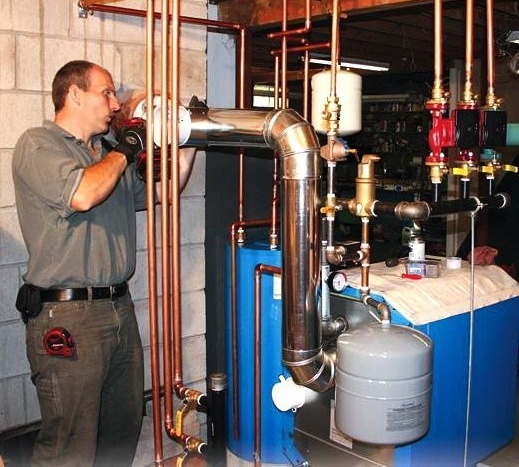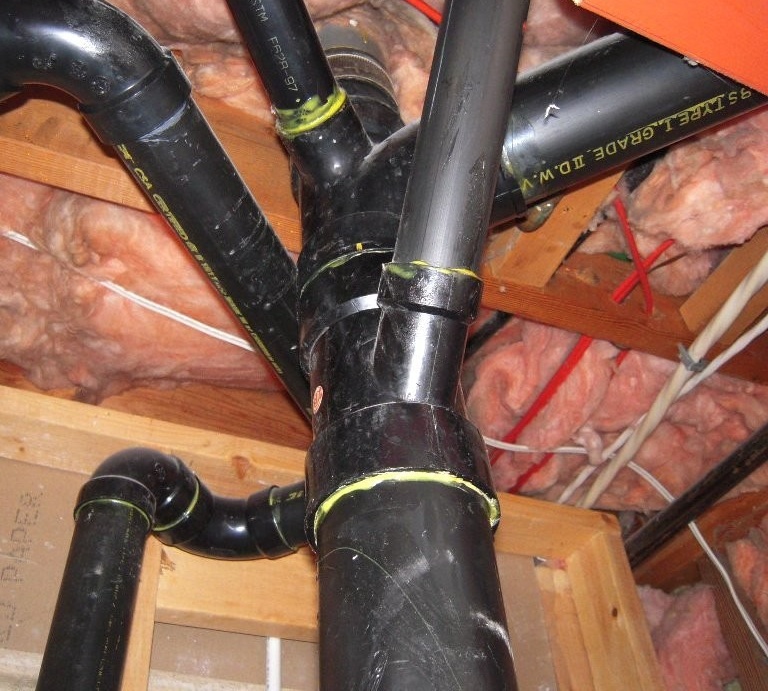How to properly tie a pellet heating boiler and not make mistakes
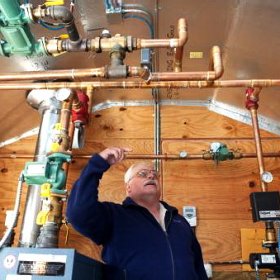
How to heat a house that is not connected to the gas main? Of course, pellets! Pellet boiler is much more convenient to use than other heating equipment for solid fuel. And since the cost of fuel is not high, heating costs can be significantly reduced. Automatic control allows maintenance of the system no more than once a month. However, the uninterrupted and efficient operation of expensive equipment largely depends on how correctly the pellet boiler was strapped.
Content
Features of the operation and installation of pellet boilers
Although pellet boilers are classified as solid fuel equipment, they are an order of magnitude better than traditional units in which they burn wood or coal, because:
- dry pellets burn out, giving off much more heat, which significantly increases the efficiency of the unit;
- during operation, the minimum amount of fuel combustion products is produced;
- pellets are loaded into the hopper much less frequently than when using firewood or coal.
This effect is achieved due to the special design of the equipment, as well as through the use of highly efficient pyrolysis combustion processes. An important point in the operation of the pellet boiler is the humidity of the fuel, which should be less than 20%. If this requirement is not met, in the future the equipment capacity will decrease and condensed moisture will get into the system. And this can very soon lead to serious equipment breakdowns.
There are combined pellet boilers in which there are two furnaces: one for burning pellets, the other for ordinary solid fuels. The efficiency of such units is slightly lower than that of boilers that operate only on pellets, and the requirements for installation and piping remain quite high.
During installation of the pellet boiler, it is necessary to install a hopper, a burner and a screw mechanism for feeding pellets. Often, experts recommend using a special buffer tank, the volume of which can be 50 liters per kW of pellet boiler power. All this significantly increases the size of the boiler room in which the installation and equipment strapping.
How is such equipment strapped?
The general installation scheme for heating boilers consists of the following series of steps:
- installation of distribution combs;
- installation of appropriate pump circuits for each consumer;
- installation of safety equipment;
- installation of an expansion tank;
- installation of shutoff valves;
- connection of the boiler to the supply and return circuits;
- filling the circuits with coolant;
- crimping equipment and checking its operation.
In practice, it all depends on the capacity of the equipment, the number of consumers, the design features of the boiler, etc. It should be noted that quite high requirements are imposed on the binding of pellet boilers. Firstly, because the humidity of the fuel should remain reasonably low, and secondly, since both the fuel and the coolant are heated to very high temperatures. Poor quality piping can lead to the fact that the operating conditions of the equipment will be violated, and the boiler will quickly fail.
In accordance with fire safety standards, it is recommended to use non-combustible metal pipelines for strapping pellet boilers. The use of polypropylene structures in practice is not only dangerous, but also not profitable, since the temperature of the coolant at the outlet of the boiler often exceeds the performance of polymeric materials. As a result, in a couple of years, the pipelines will have to be replaced.
More information about tying boilers with polypropylene can be found here:https://aquatech.tomathouse.com/en/otoplenie/raschety/sxemy-obvyazki-kotla-polipropilenom.html
Pellet boiler - the device is quite complicated. Experts strongly recommend that inexperienced beginners engage in the installation and strapping of such devices. However, knowledge of the main stages of the strapping and some of the nuances of this process will allow you to effectively monitor the work of the invited team of installers.

The diagram shows one of the options for tying a pellet heating boiler: 1 - MK pump; 2 - mixing tap MK; 3 - pump TK1; 4 - mixing crane TK1; 5 - water recirculation in TK1; 6 - pump TK2; 7 - mixing crane TK2; 8 - water recirculation in TK2; 9 - DHW pump; 10 - DHW heat exchanger; 11 - supply of running water to the hot water supply
To strapping a pellet boiler, you must:
- perform boiler installation;
- connect the appropriate burner (if a combined boiler model is used);
- install a pellet hopper;
- connect the auger for fuel supply;
- connect the boiler automatic control panel.
After that you should do:
- Installation for the supply of the boiler of the safety group, which includes a manometer, an automatic air vent and a relief valve.
- Installing a thermal valve sensor, if required by the model design;
- Installation of a chimney, the diameter and height of which correspond to technical requirements.
- Installation of a system of devices for maintaining the return flow: two pressure gauges for supply and return, a circulation pump and a thermal head.
- If there is a high probability of sudden power outages, it is recommended to supplement the system with a suitable UPS model.
Supporting the return flow allows you to control the level of heating of the coolant before it enters the system. Until the return temperature reaches the required level (usually 60 degrees and above), the coolant will remain within the small circulation circle. Only when the coolant is heated to the required level, the thermal head will open and cold coolant will flow through it, and the hot one will begin to circulate in the main circle.
In no case should you use a pellet boiler with a low coolant temperature. A temperature of 55 degrees is the so-called “dew point”, upon reaching which a significant amount of condensate forms. As a result, the volume of soot in the chimney, as well as on the heat exchanger, can increase significantly. The equipment will require additional maintenance efforts, and its power will noticeably decrease.

This is how the combustion chamber of a pellet heating boiler looks after exposure to excess condensate that appears due to errors in the installation of the recirculation system
A review of the coolants is a separate article on our portal. What types exist, what to use for different types of systems, read here:https://aquatech.tomathouse.com/en/otoplenie/radiatory/teplonositel-dlya-sistem-otopleniya.html.
The process of tying a combined pellet boiler is presented in detail in the video:
Many manufacturers of pellet boilers recommend supplementing the design with a special storage tank, which allows you to accumulate heat. Fuel economy can reach 20-30%. In addition, the use of a storage tank allows you to avoid overheating of the boiler and achieve the highest possible efficiency.
How to check pellets for quality and choose them correctly, read in our material:https://aquatech.tomathouse.com/en/otoplenie/documents/toplivnye-granuly-pellety.html.
A few words about the chimney
Good draft largely determines the efficiency of the pellet boiler. If the chimney is arranged correctly, it will provide sufficient traction in any wind and air temperature. First of all, remember that the diameter of the chimney should be the same as the dimensions of the outlet pipe. In such a chimney, a condensate drainage device must be installed. A correctly installed cap will not create an aerodynamic backwater or block the pipe section.
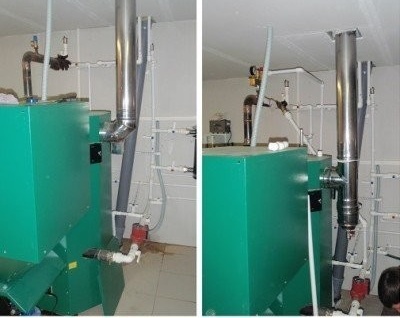
The photo shows two installation options for the chimney of a pellet heating boiler. The wrong option is shown on the left, the chimney is installed correctly on the right
Typically, metal pipes are used for chimneys, which should be equipped with hatches for cleaning, as well as carefully insulated. The clearance between the outer surface of the chimney and the elements of the ceilings and the roof must be at least 130 mm. It should be remembered that for pellet boilers, too much traction and too little traction is dangerous. To eliminate this problem, you will need a slide gate or draft stabilizer.
Common mistakes and their elimination
Inexperienced installers during the installation of pellet boilers often make a number of dangerous mistakes. Here are the most common ones:
- The master neglects to install a control system for the level of heating of the return water, which causes an increase in the amount of condensate, carbon deposits and tar.
- The sealing of the boiler, hopper or chimney is broken, which leads to the leakage of pyrolysis gases and significantly reduces the efficiency of the equipment.
- No thermal insulation work was carried out during installation of the base. On a thin floor in winter, such a boiler "freezes", as a result of which harmful condensate forms.
- The pellet burner bowl is not installed correctly. Most often, instead of it, a bowl is designed for other types of fuel.
- The size of the boiler room does not allow you to freely remove the long auger for feeding pellets to clean the hopper.
Not if you seem to have done everything correctly, but the boiler smokes, smokes, suddenly goes out, and pellets that are not completely burned to the end are found in the ash pan, so after the start-up, the boiler was not set up correctly or was not set up at all.
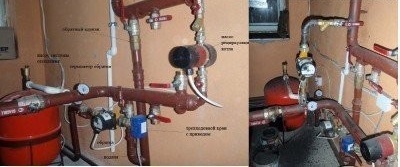
On the left is a handicraft version of the binding of a pellet heating boiler, made with errors. The right strapping corrected by an experienced craftsman is shown on the right (click to enlarge)
Do not rely on the factory settings of the pellet boiler. It must be adjusted during the first start-up, taking into account the actual state of the fuel, the set power and the draft of the chimney.
